Related Research Articles

Bangladesh, officially the People's Republic of Bangladesh, is a country in South Asia. It is the eighth-most populous country in the world and is among the most densely populated countries with a population of nearly 174 million in an area of 148,460 square kilometres (57,320 sq mi). Bangladesh shares land borders with India to the west, north, and east, and Myanmar to the southeast; to the south it has a coastline along the Bay of Bengal. It is narrowly separated from Bhutan and Nepal by the Siliguri Corridor; and from China by the Indian state of Sikkim in the north. Dhaka, the capital and largest city, is the nation's political, financial and cultural centre. Chittagong, the second-largest city, is the busiest port on the Bay of Bengal. The official language is Bengali.

Dhaka, formerly known as Dacca, is the capital and largest city of Bangladesh. It is the ninth-largest and seventh-most densely populated city in the world. Dhaka is a megacity, and has a population of 10.2 million residents as of 2022, and a population of over 22.4 million residents in Dhaka Metropolitan Area. It is widely considered to be the most densely populated built-up urban area in the world. Dhaka is the most important cultural, economic, and scientific hub of Eastern South Asia, as well as a major Muslim-majority city. Dhaka ranks third in South Asia and 39th in the world in terms of GDP. Lying on the Ganges Delta, it is bounded by the Buriganga, Turag, Dhaleshwari and Shitalakshya rivers. Dhaka is also the largest Bengali-speaking city in the world.

Chittagong, officially Chattogram, also known as Chatgaon, is the second-largest city in Bangladesh after Dhaka and the third largest city in the Bengal region after Dhaka and Kolkata. It is the administrative seat of the eponymous division and district. It hosts the busiest seaport on the Bay of Bengal. The city is located on the banks of the Karnaphuli River between the Chittagong Hill Tracts and the Bay of Bengal. The Greater Chittagong Area had a population of more than 5.2 million in 2022. In 2020, the city area had a population of more than 3.9 million. Even amidst heightened global uncertainty, Bangladesh has consistently demonstrated a robust history of growth and advancement.
Manarat International University (MIU) is a private university in Dhaka, Bangladesh. It was established in 2001 by the Manarat Trust.
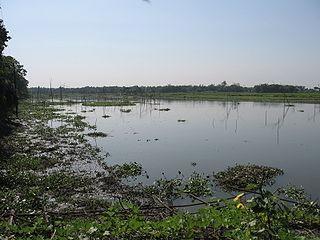
A beel is a billabong or a lake-like wetland with static water as opposed to moving water in rivers and canals - typically called khāls in Bengali, in the Ganges - Brahmaputra flood plains of Bangladesh, and the Indian states of West Bengal and Assam. The term owes its origins to the word of the same pronunciation meaning "pond" and "lake" in the Bengali and Assamese languages.
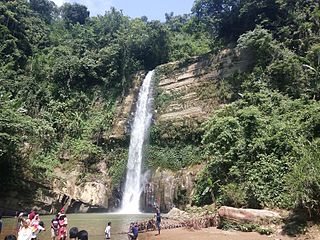
Barlekha is an upazila (sub-district) of Moulvibazar District, located in Bangladesh's Sylhet Division.
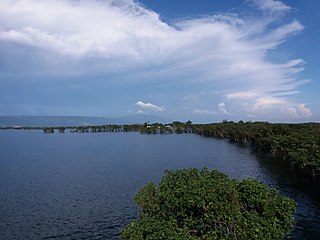
A haor is a wetland ecosystem in the north eastern part of Bangladesh which physically is a bowl or saucer shaped shallow depression, also known as a backswamp. During monsoons haors receive surface runoff water from rivers and canals to become vast stretches of turbulent water.
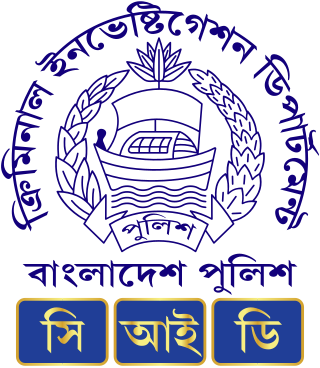
The Criminal Investigation Department (CID) is a specialized intelligence and investigation wing of the Bangladesh Police. It is headquartered in Malibagh, Dhaka and maintains a training school named the Detective Training School. Personnel attached to this wing essentially work in plain clothes. Mohammad Ali Mia, BPM, PPM is the head of the Criminal Investigation Department.

The University of Dhaka is a public research university located in Shahbag in Dhaka, Bangladesh. It was established in 1921 as University of Dacca and it is the oldest active university in Bangladesh.

Mirza Abbas Uddin Ahmed, known as Mirza Abbas, is a Bangladesh Nationalist Party politician and a member of the national standing committee of the party. He was the Mayor of Dhaka City Corporation from 1990 to 1994. He was the Member of Parliament (MP) for Dhaka-6 from 2001 to 2006, and Minister of Housing and Public Works in Khaleda's cabinet.

The Rampal Power Station is a 1320 megawatt coal-fired power station currently under construction at Rampal Upazila of Bagerhat District in Khulna, Bangladesh. The power plant is being constructed on an area of over 1834 acres of land, is situated 14 kilometres north of the world's largest mangrove forest Sundarbans which is a UNESCO World Heritage Site. It will be the country's largest power plant.
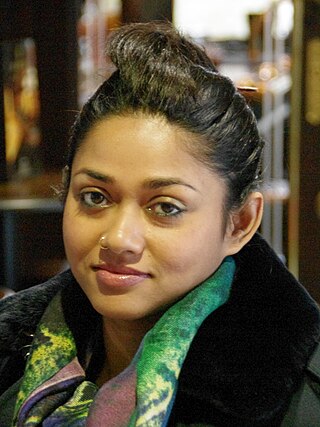
National Film Award for Best Director is the highest award for film directors in Bangladesh, presented annually at Bangladesh National Film Awards ceremony by the Ministry of Information. It is given in honour of a film director who has exhibited excellence directing in Bangladeshi cinema. Since 1975, the award is given annually except in 1981, 1998 and 2003. It is presented by the President of Bangladesh at a ceremony held in Dhaka.
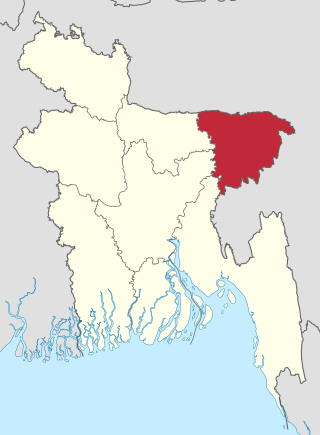
The economy of Sylhet is the 5th largest in the Peoples Republic of Bangladesh. It has a gross state product of $16 billion in nominal terms, and $40 billion in terms of purchasing power parity, making it the third largest behind Dhaka, Chittagong, Khulna and Rajshahi. Since the formation of Bangladesh, Sylhet has been regarded as the spiritual and cultural center of the country, and often termed as the agricultural capital of Bangladesh. Due to vast natural resources and emerging metropolitan, Sylhet is a major economic hub of the country alongside Dhaka and Chittagong. In recent years, Sylhet is experiencing major infrastructural developments, and projected to be the forefront of Bangladesh's economic growth. Sylhet is known for its tea plantations. About 80% of the country's agar processing factories are located in Barlekha Upazila.
The Bangladesh National Award for Best Film is one of the categories in the National Film Awards presented annually by the Department of Films and Publications, the organisation set up by Ministry of Information in Bangladesh. It is the highest award for films in Bangladesh. This award goes to the producers of the film and is the only category in a year. The award comprises a medal, a certificate, and a cash prize of ৳50,000.
Bangladesh National Film Award for Best Supporting Actress is the highest award for film actresses in a supporting role in Bangladesh.
Shamim Sikder was a Bangladeshi sculptor. Sikder served as a professor at the Faculty of Fine Arts, University of Dhaka between 1980–2001. She was awarded the Ekushey Padak in 2000 by the Government of Bangladesh.
Wheelchair Cricket Welfare Association Bangladesh (WCWAB) is a national level non-government and non profit voluntary organization established for the development of the physically challenged people of Bangladesh. The organization was formed by wheelchair cricketer Mohammad Mohasin. The organization has been working for the disabled people since 2010 aiming to incorporate the persons with disabilities & to strengthen in mainstream society. In 2016, the organization registered under the Social Welfare Department of Bangladesh. WCWAB have elected management board. The warriors on the wheel chairs started their journey of playing cricket in 2010. Since then, Bangladeshi Wheelchair cricket players have participated in major tournaments like ICRC International Cricket Tournament in Bangladesh and Asia Cup in India.

Sadeka Halim is an academic. She is the incumbent and first female vice-chancellor of Jagannath University, appointed by the President of Bangladesh since November 2023. She was a professor at Dhaka University and the first female dean of the Faculty of Social Sciences of the university. She is the first female to be the Information Commissioner of Bangladesh.
Zakaria Khan Chowdhury was a Bangladesh Nationalist Party politician and a Member of Parliament from Habiganj-2.

Nikli Haor is located in Nikli Upazila, Kishoreganj, Bangladesh. It is about 110 km away from country's capital Dhaka. Apart from Nikli Upazila, the perimeter of this haor extends to the adjoining Mithamain, Austagram and Itna Upazilas. It is one of the largest freshwater wetlands in Bangladesh and also a popular tourist destination. Easy road and rail connectivity with capital Dhaka is one of the reasons for the increase in tourism in this haor. With the establishment of several residential hotels in Nikli, tourists are now getting the benefit of visiting Haor for more than one day. In the monsoon, when this haor is filled with water, the number of tourists increases exponentially.
References
- 1 2 "About BHWDB". Department of Bangladesh Haor and Wetland Development. Archived from the original on 22 November 2016. Retrieved 21 November 2016.
- ↑ "PM for proper utilisation of wetlands". The Daily Star. 6 May 2016. Retrieved 21 November 2016.
- ↑ "Sorry tale of haor people". The Daily Star. 17 October 2015. Retrieved 21 November 2016.
- ↑ "Haor-wetland board to be autonomous". Dhaka Tribune. Archived from the original on 22 November 2016. Retrieved 21 November 2016.